2. 中国科学院地质与地球物理研究所岩石圈演化国家重点实验室, 北京 100029;
3. 中国科学院地球科学研究院, 北京 100029;
4. 中国科学院大学, 北京 100049
2. State Key Laboratory of Lithospheric Evolution, Institute of Geology and Geophysics, Chinese Academy of Sciences, Beijing 100029, China;
3. Institutions of Earth Science, Chinese Academy of Sciences, Beijing 100029, China;
4. University of Chinese Academy of Sciences, Beijing 100049, China
渤海湾盆地是华北最大的新生代裂谷盆地,也是中国东部主要含油气盆地之一,其新生代以来的构造-热演化一直备受中外学者关注.目前,学者们对渤海湾盆地新生代构造的差异演化研究得比较充分(王子煜等, 2000; 任凤楼等, 2008; 汤良杰等, 2008; 李倩茹, 2014),认为盆地具有逐渐向东的构造迁移,表现为断层、沉积和沉降中心以及岩浆活动向东迁移、年代变新(任凤楼等, 2008; Hou and Hari, 2014; Zhao et al., 2016).然而,盆地各构造单元拉张及热史演化的差异性仍缺乏系统研究.大部分成果主要集中在油气勘探程度较高的地区(如济阳坳陷)(He and Wang, 2003; Qiu et al., 2014).对渤海湾盆地新生代拉张强度的研究主要依赖于平衡剖面的恢复(杨明慧等, 2002; 董敏等, 2013; Hou and Hari, 2014; 李倩茹, 2014; 张江涛等, 2014),其基于多种假设且精度有待提高.多数关于盆地热历史的研究基于镜质体反射率及磷灰石裂变径迹等古温标,但对于现今达到最高古地温的一些地区,古温标方法可能受限.有研究认为渤海湾盆地多数坳陷的古热流在古近纪中、晚期达到峰值大于80 mW·m-2(Zuo et al., 2013; Qiu et al., 2014, 2015, 2016; Chang et al., 2018),但Hu等(2001)和Wang等(2003)则认为渤海海域和辽河坳陷的热流在古近纪末达到最大值70~90 mW·m-2.可见,盆地各坳陷的热历史可能存在差异.
构造-热演化模拟是研究盆地热历史的另一种手段,其不仅可以重建盆地热流演化史,同时可获得不同时期的拉张系数及应变速率,为了解盆地裂陷过程及动力学机制提供帮助.此外,构造-热演化模拟不受样品数量的限制,能够对全盆地进行对比研究,可与古温标反演的热史结果相互验证.渤海湾盆地具有完整的新生代地层,大量地震剖面、钻井资料及热流数据为构造-热演化模拟提供了基础数据.然而,目前对该盆地构造-热演化数值模拟的研究并不多(He and Wang, 2003, 2004; Xie et al., 2007; Liu et al., 2016a).开展对渤海湾盆地内主要坳陷新生代的构造-热演化模拟研究,可以揭示盆地拉张强度及热演化的时空差异性,为盆地新生代演化的深部动力学机制提供启示.
本文通过初始地壳、岩石圈厚度可变的二维多期拉张模型,对覆盖渤海湾盆地主要坳陷的九条地震解释剖面进行构造-热演化模拟.通过模拟,获得了盆地新生代各裂陷幕的拉张系数,进而预测了盆地基底热流的演化史.
1 地质及地球物理背景 1.1 地质概况渤海湾盆地位于华北东部,为中-新生代裂陷盆地.盆地北部为燕山造山带,西部毗邻太行山东麓断裂带,东部临近郯城—庐江断裂带,南部是鲁西隆起区.燕山期以来发育的北东向、北北东向和新近纪出现的近东西向三组主要的继承性张性断裂(高祥林, 2006),控制了渤海湾盆地隆起或坳陷的发生、发展和沉积、沉降过程.以这些主要断层为边界把整个渤海湾盆地分割成了冀中、黄骅、临清—东濮、济阳、渤中、辽河六个大坳陷区及沧县、埕宁和内黄三个大隆起区(图 1a).新生界是渤海湾盆地沉积地层的主体,其沉积特征反映了裂谷盆地张裂—深陷—消亡的完整过程.盆地新生界地层厚几百米至近万米,最大累计厚度超过12 km(Qi and Yang, 2010);自下而上分别为:古近系孔店组、沙河街组、东营组、新近系馆陶组、明化镇组及第四系平原组(图 1b).

|
图 1 渤海湾盆地综合地质及地球物理图 (a)构造简图(改自Qi and Yang, 2010);(b)新生代综合地层柱(改自董敏等, 2012);(c)大地热流图(改自Liu et al., 2016b).各地层底界年龄在不同坳陷略有差别(陈振岩等, 2011; 董敏等, 2012; Zuo et al., 2014; Qiu et al., 2015).其中东濮—临清坳陷的东营组及沙一段底界年龄分别为33及35 Ma;沙三段底界年龄在黄骅、冀中、辽河坳陷为43 Ma,在东濮—临清坳陷为45 Ma;沙四段底界年龄在辽河坳陷为45.5 Ma;古新世—始新世晚期在辽河坳陷沉积房身泡组(65~45.5 Ma). Fig. 1 Comprehensive geological and geophysical map of the Bohai Bay Basin (a) Structural map (modified from Qi and Yang, 2010); (b) Generalized Cenozoic stratigraphic column (modified from Dong et al., 2012); (c) Heat flow map (modified from Liu et al., 2016b). The lower boundary ages of some strata are slightly different in different depressions (Chen et al., 2011; Dong et al., 2012; Zuo et al., 2014; Qiu et al., 2015). The lower boundary ages of the E3d and E3s1 are 33 and 35 Ma in the Linqing-Dongpu Depression. The lower boundary age of the E2s3 is 43 Ma in the Huanghua, Jizhong and Liaohe depressions, and is 45 Ma in the Linqing-Dongpu depression. In the Liaohe depression, the oldest age of the E2s4 is 45.5 Ma and the Fangshenpao Formation (E1f) was deposited during 65~45.5 Ma. |
渤海湾盆地新生代构造演化经历了古近纪裂陷沉降阶段和新近纪至第四纪后裂陷阶段,基本完成了一个完整的裂陷作用旋回(Allen et al., 1997; Ren et al., 2002).裂陷期发生了多幕裂陷,多幕沉降充填,可大致划分为孔店组—沙四段、沙三段、沙二段—东营组沉积时期的三个裂陷伸展幕,不同坳陷裂陷伸展幕的划分略有差异(Allen et al., 1997; Hu et al., 2001; Ren et al., 2002; 朱伟林等, 2009; Liu et al., 2018).渐新世末,盆地裂陷作用基本结束,进入裂后热沉降阶段直至现今(Allen et al., 1997; Qiu et al., 2015).
1.2 大地热流目前,渤海湾盆地内共有实测大地热流数据193个(Liu et al., 2018, 不含D类热流数据).盆地热流值分布在44~106 mW·m-2(图 1c),算术平均值为66±11 mW·m-2,1°×1°网格热流平均值为64±8 mW·m-2(Liu et al., 2016a).该热流值高于中国大陆地区平均热流值(60 mW·m-2,姜光政等, 2016),接近全球大陆热流平均值(65 mW·m-2,Davies, 2013),与新生代地质体热流范围的下限(64 mW·m-2,Pollack et al., 1993)相当.盆地热流总体上有自东向西递减的趋势.东部的渤中、辽河坳陷、济阳坳陷东部热流值较高(>70 mW·m-2),而盆地西北部临近太行山和燕山的区域则小于55 mW·m-2.
1.3 地壳厚度渤海湾盆地莫霍面埋深介于28~37 km(Zheng et al., 2005, 2007; Duan et al., 2016).地壳厚度自东部渤海海域的28 km左右向西北部太行山逐渐增至36~37 km.其中莫霍面埋深最浅的地方位于渤中坳陷,约28 km;冀中坳陷的Moho面深度为32~37 km,黄骅坳陷为29~33 km,辽河坳陷为32~33 km,济阳坳陷为29~33 km,临清坳陷为33~34 km,东濮坳陷为34~37 km.
2 构造沉降史恢复本研究采用回剥技术,根据沉积压实原理和质量守恒法则,从已知的现今地层厚度出发,按地质年代逐层回剥到地表,并进行压实、古水深和海平面变化的校正,从而得到各地层在不同地质时期的真实埋藏深度及构造沉降量(Sclater and Christie, 1980).本文选取位于渤中、黄骅、冀中、济阳、临清、东濮、辽东湾及下辽河坳陷的9条二维地震解释剖面(AA′-Ⅱ',图 2),对其进行构造沉降史恢复,以为构造-热演化模拟提供约束.
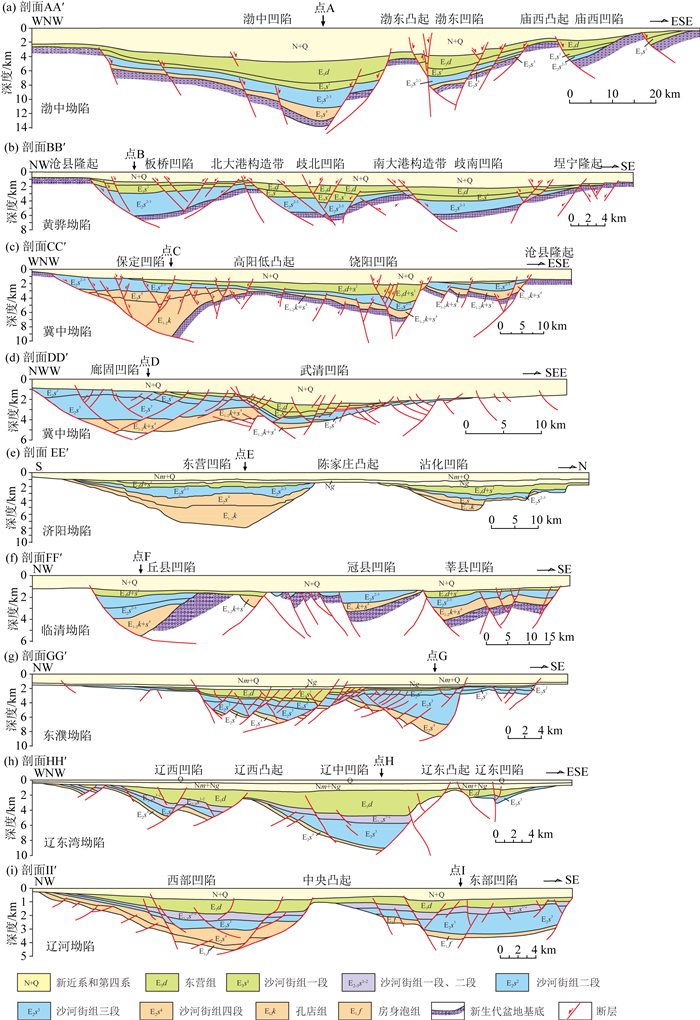
|
图 2 地震解释剖面(剖面位置见图 1a) 改自Guo等(2007), Qi和Yang(2010), 程秀申(2011), 李倩茹(2014), 毛黎光(2014)和张江涛等(2014). Fig. 2 Strata of the modeled profiles that were interpreted from 2D seismic data (see Fig. 1 for location) Modified from Guo et al. (2007), Qi and Yang (2010), Cheng (2011), Li (2014), Mao (2014) and Zhang et al.(2014). |
构造沉降史的恢复需要大量基础数据,包括岩性特征、密度、孔隙度、地层年代及现今地层分层数据等.由于研究区地层岩性主要为砂岩和泥岩,在做沉降史分析时只考虑这两种岩性的含量百分比.通过统计渤海湾盆地大量钻井资料并参考前人的研究(王子煜等, 2000; Wang et al., 2002),得到各坳陷不同地层单元的砂、泥岩含量百分比(表 1).不同地层岩石密度和孔隙度数据按照其所含砂、泥岩百分含量加权平均求取.砂、泥岩的初始孔隙度、压实系数主要参考前人在不同地区的研究成果(表 2).砂岩密度取2640 kg·m-3,泥岩密度取2500 kg·m-3,地幔密度取3300 kg·m-3,水的密度取1000 kg·m-3(Hu et al., 2001; 朱伟林等, 2009).各坳陷的地层年龄依图 1b.回剥模型中孔隙度与深度的关系服从指数分布,按正常压实情况计算.由于渤海盆地新生代总体为河流-浅湖相沉积环境,其古水深不超过50 m,因此模拟中可以忽略古水深和水平面变化(Xie et al., 2007; 汤良杰等, 2008).
|
|
表 1 渤海湾盆地各坳陷地层砂、泥岩百分含量 Table 1 Percentages of sandstone and mudstone within each stratigraphic unit for different depressions |
|
|
表 2 渤海湾盆地各坳陷砂、泥岩初始孔隙度及压实系数 Table 2 Initial porosities and compaction factors for sandstone and mudstone in different depressions |
由上述方法及物性参数,恢复了盆地各坳陷的构造沉降史,结果见图 3.可以看出,各坳陷总体呈幕式拉张.由于一些地震解释剖面对地层的划分不够详细,在划分拉张期次时结合了大量前人对各坳陷构造演化的研究成果(Allen et al., 1997; Hu et al., 2001; Ren et al., 2002; Xie et al., 2007; 任凤楼等, 2008; 朱伟林等, 2009; 陈振岩等, 2011; 董敏等, 2012; Qiu et al., 2014, 2015).

|
图 3 各剖面人工井构造沉降史(载水沉降)及裂陷幕划分(示以罗马数字) Fig. 3 Tectonic subsidence evolution curves of artificial wells from the profiles (water-loaded stratigraphy) and division of rift episodes (denoted by Roman numerals) |
本研究使用二维非瞬时多幕拉张模型(Liu et al., 2016a)模拟构造-热演化史.模型基于岩石圈纯剪变形假设(McKenzie, 1978),并考虑多幕有限时拉张的继承性(何丽娟, 1999).模型下边界固定于125 km,并保持1330 ℃.上边界随沉降移动,温度保持0 ℃.假定侧边界水平热流通量为0.初始温度场根据稳态热传导方程计算得到.
初始岩石圈、地壳厚度的选择,对构造热演化的影响非常大,尤其是对构造沉降量的影响尤为显著(Liu and He, 2015),这将最终影响拉张因子的确定.由于中生代期间华北克拉通东部岩石圈已发生过减薄(Zhu et al., 2012),渤海湾盆地早新生代拉张开始前的岩石圈厚度是不确定的,并不一定为前人普遍使用的125 km(McKenzie, 1978),同样初始地壳厚度也是未知的,因此在模拟中使用初始地壳及岩石圈厚度可变的拉张模型,初始岩石圈底界与模型底边界之间为软流圈.
该模型中,剖面在横向上被分为N列,各列在盆地演化的过程中保持垂直.同一列网格中的拉张系数是相同的,但横向上非均匀变形时不同列的拉张系数是不同的.拉张期次的划分结合剖面恢复得到的构造沉降史及前人对剖面所在地区构造演化的研究得出.具体到一期构造-热事件时,在裂陷期,拉张以恒定的速率持续有限时间,每一列被拉伸了βi(i=1, …, N)倍,并减薄1/βi,岩石圈底部随时间上移,地温梯度升高;当模型底部网格变形严重以致网格质量很差时,模型底部将增加网格点.多幕拉张时,将前一幕拉张结束时的岩石圈厚度及温度场作为下一幕拉张开始时的初始条件.总的拉张系数为各幕拉张系数的乘积.拉张结束后进入热沉降期,温度场逐渐冷却,由1200 ℃等温线确定热岩石圈底界(Petitjean et al., 2006; He, 2014).
变形岩石圈的瞬时温度场通过求解二维热传导方程得到,公式为

|
(1) |
其中,ρ为密度,c为比热容,T为温度,t为时间,k为热导率,A为放射性生热率.在本模型中,作者引入了软流圈等效热导率(Liu and He, 2015),通过在热传导方程中提高热导率以等效模拟软流圈对流的热效应.由于热沉降期的构造沉降对软流圈等效热导率相对敏感(Liu and He, 2015),以构造沉降速率进行约束,最终确定15 W·m-1K-1作为渤海湾盆地软流圈等效热导率的值是比较合理的.表 3中列出了模拟中使用的所有热物性参数.
|
|
表 3 模型中使用的热物性参数 Table 3 Thermal property values used in modeling |
模型预测的总构造沉降量为同裂陷沉降量加上热沉降量.将模型预测的构造沉降量和通过现今地层利用回剥法得到的实际构造沉降量进行拟合来反演该期拉张的拉张系数.模拟中通过模拟退火法实现上述反演过程,目标函数为

|
(2) |
其中,siobs和sipre分别为第i列上观测的和预测的构造沉降量,β=[β1, β2, …, βN].当目标函数小于某个容许界限时,迭代终止,输出该裂陷幕各列的拉张系数.对于多幕拉张的情况,对每一幕重复上述计算步骤.
模拟过程中,给定多组初始地壳及岩石圈厚度,每给定一组初始厚度,则通过拟合构造沉降量确定剖面在每一裂陷幕的拉张系数,并可进一步预测盆地现今基底热流、莫霍面深度及热岩石圈厚度,将这些预测值和观测值进行对比能够对初始地壳及岩石圈厚度提供约束.通过不断调整初始厚度值,就能确定与观测值拟合最好时的初始地壳及岩石圈厚度.
4 模拟结果及不确定性分析 4.1 模拟结果模拟时使用多组初始地壳及岩石圈厚度值进行试算,将沿各剖面的现今热流(图 1c)及地壳厚度(CRUST1.0模型,Laske et al., 2013)作为约束,确定出最佳的初始厚度值(表 4).盆地各坳陷的初始地壳厚度在33~39 km,初始岩石圈厚度在80~105 km.磷灰石裂变径迹和镜质体反射率等古温标方法及幔源捕掳体约束得到中生代末岩石圈的厚度为80~100 km(王冬艳等, 2002; Zuo et al., 2013; Qiu et al., 2016),与本研究得到的初始厚度值十分吻合.
|
|
表 4 各坳陷初始地壳及岩石圈厚度 Table 4 Initial thicknesses of the crust and lithosphere for different depressions |
确定了初始地壳及岩石圈厚度之后,不同坳陷各裂陷幕的拉张系数也相应地确定了(表 5).结果显示,新生代期间渤海海域渤中坳陷和辽东湾坳陷的总拉张系数最大,其次是冀中坳陷西部的保定凹陷及济阳坳陷;拉张系数较小的是辽河坳陷和临清坳陷.前人通过平衡剖面分析恢复的盆地新生代伸展率表明:渤海海域古近纪总伸展率达1.71,济阳坳陷达1.73,黄骅坳陷新生代伸展率为1.37,冀中坳陷为1.76,东濮坳陷为1.56,辽河坳陷为1.28(杨明慧等, 2002; 刘见宝, 2011; 董敏等, 2013; Hou and Hari, 2014; 张江涛等, 2014).本文通过构造-热演化模拟得到的拉张系数与上述研究结果具可比性.
|
|
表 5 渤海湾盆地各坳陷新生代拉张系数 Table 5 Cenozoic stretching factors of different depressions |
将盆地各坳陷各地质时期的拉张系数进行对比(图 4),从各时期的平均值来看,新生代拉张系数最大的时期为沙河街组三段沉积时期,其次为孔店组及沙河街组四段沉积时期,沙河街组一段和二段沉积时期的拉张系数最小.就每个地质时期而言,孔店组沉积时期,冀中坳陷和济阳坳陷的拉张系数最大,其次是临清及辽河坳陷.沙河街组四段沉积时期,渤中坳陷相比其他坳陷拉张系数最大,东濮及冀中坳陷的拉张系数也相对较大,而黄骅和辽河坳陷的拉张量很小.沙河街组三段沉积时期,辽东湾、东濮、黄骅及渤中坳陷的拉张系数都很大,在1.2以上;济阳、冀中坳陷的拉张系数相对较小.沙河街组二段沉积时期,各坳陷普遍拉张量很小,仅黄骅坳陷略大.沙河街组一段沉积时期时,渤中坳陷的拉张系数最大,其次是黄骅坳陷,其他坳陷的拉张量总体偏低.东营组沉积时期,渤海海域的渤中和辽东湾坳陷拉张量最大,而其他各坳陷的拉张系数则小于1.05.
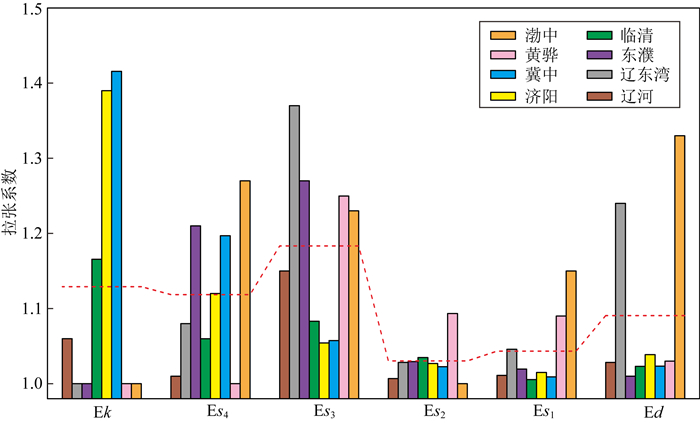
|
图 4 渤海湾盆地各坳陷各地质时期拉张系数对比(红虚线示各时期的平均值) Fig. 4 Comparison of the stretching factors among geological periods for different depressions of the Bohai Bay Basin (The red dash line represents the average stretching factor during each period) |
通过模拟,在得到岩石圈拉张系数的同时,也获得了各地质时期盆地基底处(即沉积盖层最底部)的热流.由图 5可见,盆地的基底热流自新生代初的59~66 mW·m-2开始升高,在36~24.6 Ma达到峰值71~100 mW·m-2,之后热流逐渐降低至现今.各坳陷热流达峰期的时间有所不同,盆地西部热流达到峰期的时间比东部早.冀中坳陷西部保定凹陷、北部廊固凹陷及临清坳陷的热流峰期在36~35 Ma,东濮坳陷为33 Ma,而渤中、辽河、济阳、黄骅及辽东湾坳陷则在24.6 Ma左右基底热流达到最高.
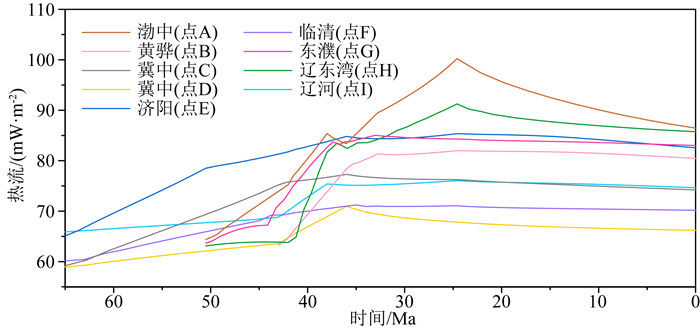
|
图 5 渤海湾盆地各坳陷基底热流随时间的演化 Fig. 5 Evolution of basal heat flow in each depression of the Bohai Bay Basin |
从不同时期的热流平面图上看(图 6),沙河街组四段沉积结束后,冀中坳陷西部、济阳坳陷及渤中坳陷热流较高.经过沙河街组三段及二段段沉积之后,冀中、东濮、黄骅以及辽东湾坳陷的热流明显升高,济阳坳陷成为全盆地热流最高的地方.东营组沉积结束后,冀中、临清坳陷热流有所降低,而渤海海域热流显著升高,成全区最热之处.
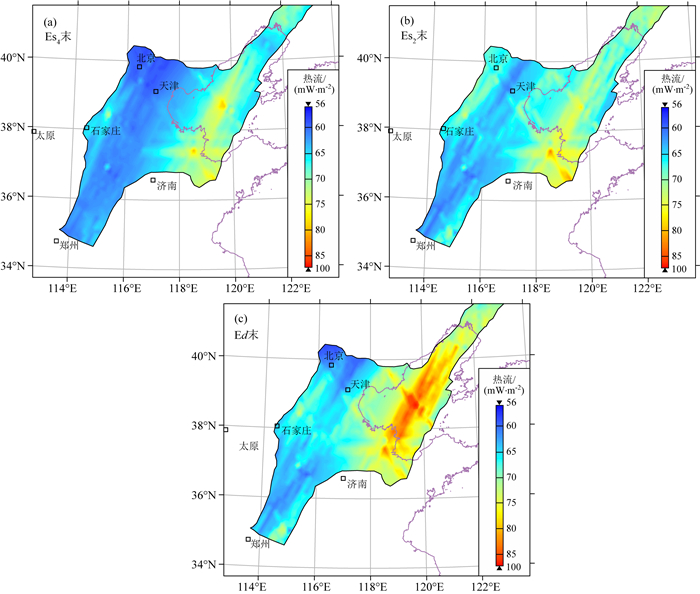
|
图 6 渤海湾盆地新生代基底热流图 (a)沙河街组四段沉积结束时;(b)沙河街组二段沉积结束时;(c)东营组沉积结束时. Fig. 6 Basal heat flow map of the Bohai Bay Basin during the Cenozoic (a) End of the sedimentation of the fourth member of the Shahejie Formation; (b) End of the sedimentation of the second member of the Shahejie Formation; (c) End of the sedimentation of the Dongying Formation. |
由于缺少深部岩石圈热物性参数的直接约束,在本研究中采用表 3给定的参数值,而不同的参数值可能会对模拟结果造成一定影响,本文对结果的不确定性进行了分析(表 6).
|
|
表 6 模拟结果的不确定性分析 Table 6 Uncertainty analysis for the modeling results |
参考模型取初始岩石圈厚90 km,初始地壳厚35 km,其中上、中地壳厚23 km.裂陷期为40 Ma, 拉张系数为1.7,热沉降期持续25 Ma.结果表明:取地壳生热率或热导率的不确定性为10%,则它仅造成总构造沉降及热流 < 2%的不确定性.若在模型中考虑地幔的放射性生热(取0.03 μW·m-3),则其对计算结果的影响也不足1%.此外,岩石圈地幔热导率10%的不确定性将造成模拟得到的总构造沉降及热流1%及3%的不确定性.由此可见,热物性参数的不确定性对本文模拟结果带来的误差在可以接受的范围内.
5 讨论 5.1 模拟结果与前人研究结果的对比 5.1.1 与捕掳体地温证据的对比捕掳体温-压条件为岩石圈的热状态提供了独立而有价值的约束.根据地质温压计可以确定幔源捕掳体中单个矿物颗粒被寄主玄武岩岩浆捕获时的矿物温度和平衡压力(起源深度).华北克拉通东部广泛出露有新生代的碱性玄武岩,其中多含有幔源橄榄岩及辉石岩包体,这为直接重建上地幔地温线提供了机会.
女山是华北克拉通东部典型的捕掳体出处(Xu et al., 1998).女山捕掳体(1.4 Ma)估算出P-T条件为1.2~2.4 MPa及900~1200 ℃(Huang and Xu, 2010).宽甸石榴石辉石岩(0.12~0.27 Ma)和山旺石榴石橄榄岩(15~14 Ma)的温压数据得到的地温曲线与女山的十分接近(图 7),意味着女山地温曲线代表了华北克拉通东部岩石圈的热状态.由该地温曲线可计算得到相应的高热流背景,约80 mW·m-2(Huang and Xu, 2010).值得注意的是,由地质温压计估算的地温曲线可以分为两段:深度小于65 km的部分斜率较大,而深度大于65 km的部分大致呈垂直的形态.这暗示华北克拉通东部的捕掳体记录了其岩石圈和软流圈不同的热传递机制:浅部岩石圈地幔由热传导机制主导,而深部软流圈地幔由热对流机制控制,其间可能有过渡层.因此,可以估算出华北克拉通东部晚新生代的岩石圈和软流圈界面在65 km左右.

|
图 7 模拟得到的盆地晚新生代地温曲线与捕掳体地温证据的对比 捕掳体深度-温度值来源:女山(Xu et al., 1998),山旺(Zheng et al., 2006),宽甸(方同辉和马鸿文, 1999),鹤壁(樊祺诚等, 2008). Fig. 7 Comparison between the modeled geotherms and xenolith-derived geotherms of the basin in the late Cenozoic Xenolith-derived depth-temperature data came from: Nüshan (Xu et al., 1998), Shanwang (Zheng et al., 2006), Kuandian (Fang and Ma, 1999), Hebi (Fan et al., 2008). |
将本文利用拉张模型在渤海湾盆地得到的晚新生代(取2.46 Ma)深度-温度曲线与上述地质温压计约束得到的地温曲线进行对比(图 7),发现二者高度吻合.模拟得到的地温曲线也由两部分组成,上段斜率较大,下段斜率变小,两段的拐点在50~70 km.其中,渤中、济阳、辽东湾坳陷的拐点在50 km左右,黄骅、东濮、冀中、辽河坳陷的拐点在60 km左右,临清坳陷的拐点略大于70 km.由于本文使用的是空盆载水模型,实际盆地的深度会更大,相应的地温曲线拐点也会稍下移.地温曲线的拐点也意味着晚新生代岩石圈和软流圈界面大致在50~70 km或略深于此深度.在本文的模型中引入了软流圈等效热导率,综合考虑了软流圈中的热传导和对流的效应,地温曲线的下段斜率很小,代表着热对流效应的存在,与捕掳体地温曲线十分相像,进一步证明了本文模型的合理性.
5.1.2 与古温标方法恢复热史的对比盆地的热历史除了可利用本文所使用的构造-热演化模拟方法来重建外,还可利用盆地沉积地层中的各种古温标(如镜质体反射率、裂变径迹、(U-Th)/He及自由基浓度等)来恢复.目前已有很多研究利用古温标方法重建了渤海湾盆地的热历史(Hu et al., 2001; Wang et al., 2003; Zuo et al., 2013; Qiu et al., 2014; Zuo et al., 2017; Chang et al., 2018).将本文模拟得到的盆地新生代热历史(图 5)和古温标方法恢复的结果进行对比(图 8),从趋势上看,两者都在古近纪中、晚期热流出现峰值,之后热流逐渐降低;且两者都表现出盆地西部的冀中、临清等坳陷热流峰期出现的早,而盆地东部渤海海域、辽河坳陷热流达最大值的时间较晚.Hu等(2001)和Wang等(2003)认为在渤海海域及辽河坳陷的古热流于约25 Ma达到最大值70~90 mW·m-2.本文的模拟结果显示,渤中、辽东湾及辽河坳陷在24.6 Ma热流达到峰值,分别为100、91及78 mW·m-2,热流比古温标方法恢复的略高.Qiu等(2014)对济阳坳陷的热史恢复得到其新生代热流在39~40 Ma达到最大值85~88 mW·m-2.本文的模拟结果得到济阳坳陷36 Ma时热流已达85 mW·m-2,到24.6 Ma时基底热流缓慢增至86 mW·m-2.Qiu等(2015)和Chang等(2018)进一步通过古温标恢复出临清、冀中及黄骅坳陷于40~42 Ma热流达到最大值80~85 mW·m-2.本文得到临清、冀中坳陷在35~36 Ma时基底热流达峰值71~77 mW·m-2,比古温标方法的结果要低.黄骅坳陷在32.8 Ma时热流已升至81 mW·m-2,之后在24.6 Ma时达最大值82 mW·m-2.

|
图 8 古温标方法恢复的渤海湾盆地新生代热历史 Fig. 8 Thermal histories of the Bohai Bay Basin reconstructed by paleo-geothermometers |
由于本文模拟得到的实际上是盆地基底处的热流,不包含盆地沉积层放射性生热及沉积作用的热效应,反映的是深部构造-热事件造成的热扰动,而忽略浅层的影响因素.而古温标方法记录盆地尺度的古热流,更接近于地表热流,其与盆地基底热流、样品埋藏史、岩石热物性参数(热导率、生热率)等都相关(Hu et al., 2001).另外,很多地质过程,如地下水的运动等也会影响古地温的记录.因此,构造-热演化模拟方法和古温标热史反演方法得到的盆地古热流可能会有所差别.
此外,当岩石圈拉张时,若应变速率×初始地壳厚度>0.25 km·Ma-1,会有明显的“热毯效应”,即盆地热流会因冷的沉积物的沉积而降低(Wangen, 1995).渤中、辽东湾坳陷新生代期间的平均应变速率达5×10-16~1×10-15 s-1(Xie et al., 2007; Liu et al., 2016a),其应变速率与初始地壳厚度的乘积远大于0.25 km·Ma-1,尤其是东营组沉积时期,其应变速率普遍较大,“热毯效应”十分明显.因此,渤海海域的沉积层放射性生热可能被其产生的“热毯效应”相抵消,盆地基底热流可能比地表热流更高.而在冀中和临清坳陷,新生代期间其应变速率多在1×10-16~2×10-16 s-1(Liu et al., 2018),“热毯效应”并没有那么显著,因而沉积层放射性生热的贡献并不能完全被抵消,盆地基底热流会比地表热流低.
另一方面,由于渤海湾盆地(尤其是渤海海域)12 Ma以来的快速沉积,使得很多凹陷在现今达到最高古地温,因而限制了古地质温度计的使用.古温标方法恢复的热历史多基于盆地古隆起或裂谷侧翼处的样品(Hu et al., 2001; Zuo et al., 2013; Qiu et al., 2014),而图 5中展示的本研究得到的盆地基底热流都选自各坳陷沉积中心处的模拟结果.盆地凸起区与凹陷区的热流是否具有一致的演化趋势有待进一步研究.
5.2 盆地新生代演化的动力学机制新生代以来,渤海湾盆地的沉积中心总体有着“自西向东,自南向北”渐进式迁移的特点(任凤楼等, 2008).由本文对盆地各坳陷的拉张系数和基底热流的研究结果可以看出(图 4-6),盆地的拉张中心从孔店组时期的冀中坳陷西部及济阳坳陷南部,经沙河街组四段、三段沉积后,迁移到辽东湾、渤中、黄骅及东濮坳陷;沙河街组一段沉积时期,盆地大部分区域拉张强度已很小,拉张中心转向黄骅及渤中坳陷;东营组沉积时期,拉张中心继续向东、向北迁移到渤海海域的渤中及辽东湾坳陷.由此可见,渤海湾盆地新生代的拉张有着自西向东,自南向北的迁移.盆地新生代拉张中心的迁移与沉积、沉降中心的迁移方向一致.
关于渤海湾盆地新生代演化的动力学机制主要有印度—欧亚板块碰撞的远程效应(Jolivet et al., 1994)、太平洋板块与欧亚板块的俯冲效应(Northrup et al., 1995; Allen et al., 1997),或两者共同作用(Ren et al., 2002).然而,欧亚板块东缘盆地初始裂陷时代明显早于印度—欧亚板块碰撞时代(始新世)(Northrup et al., 1995).在印度—欧亚板块碰撞远程效应最强烈的第四纪时期,渤海湾盆地及其周围盆地却处于热沉降阶段(Hu et al., 2001).因此,印度—欧亚板块的碰撞可能并非是渤海湾盆地构造演化的主要机制.
本文认为盆地新生代的拉张更可能与太平洋板块的俯冲相关,原因体现在:渤海湾盆地的拉张方向与西太平洋俯冲海沟近乎垂直(Guo et al., 2007; Qi and Yang, 2010);深大断裂的规模、强度及连续性自西向东都逐渐增加,表明动力源自东边(Luo et al., 2017);盆地构造活动强度及应变速率都与太平洋—欧亚板块的相对汇聚速率呈负相关关系(Liang et al., 2016; Liu et al., 2018);盆地沉积中心的迁移方向与太平洋板块相对欧亚板块漂移的方向大致吻合(Liang et al., 2016).
前人的研究表明:太平洋—欧亚板块的汇聚速率在新生代期间发生了显著的变化,两板块的汇聚速率自新生代早期不断降低,并在始新世中、晚期达到最小值;之后汇聚速率开始升高,接着在早中新世至中中新世期间汇聚速率又有所降低;自晚中新世至现今,板块汇聚速率有明显的升高(Engebretson et al., 1985; Northrup et al., 1995).Northrup等(1995)将欧亚板块边缘始新世期间广泛的拉张作用和太平洋—欧亚板块之间汇聚速率在该时期的降低联系起来,并推断缓慢的板块汇聚速率可能导致板块间水平压应力的降低,从而有助于形成强烈的拉张作用.渤海湾盆地拉张强度最大的沙河街组三段沉积时期正好对应着最缓的板块汇聚速率.Schellart(2005)通过流体动力学实验模拟指出,当板片俯冲速率很低时,会伴随快速的海沟后撤,俯冲板片向后拉,俯冲角度也随之变小,形成弧后拉张;当俯冲速率较高时,海沟后撤与稳定或前进交替出现,俯冲板片向前拽,上覆板块以挤压为主或挤压、拉张交替出现.俯冲速率和海沟总后撤量呈负相关,而上覆板块的应变速率与海沟的向后迁移速率基本呈正相关.因此,太平洋板块在新生代期间俯冲速率的变化,可能导致俯冲后撤速率的变化,从而影响上覆大陆岩石圈的应变速率,造成盆地的幕式拉张作用(图 9).Zhu等(2010)通过数值模型模拟了西太平洋板块向中国东北地区深部俯冲的过程,其尝试了不同俯冲起始时间及海沟后撤速率的模型,模拟结果验证了随着海沟后撤,盆地拉张,岩石圈减薄的过程.渤海湾盆地的拉张自65 Ma开始,拉张中心自西向东逐渐迁移,在约25 Ma拉张结束.日本海作为弧后拉张盆地,在15~30 Ma形成(Jolivet et al., 1994).太平洋板片俯冲所致的弧后拉张有着向东迁移的趋势.此外,中国东北火山岩年代学研究显示,新生代火山也在向东迁移(刘嘉麒和王松山, 1982).这些现象可能与太平洋板片俯冲的东向后撤有关.
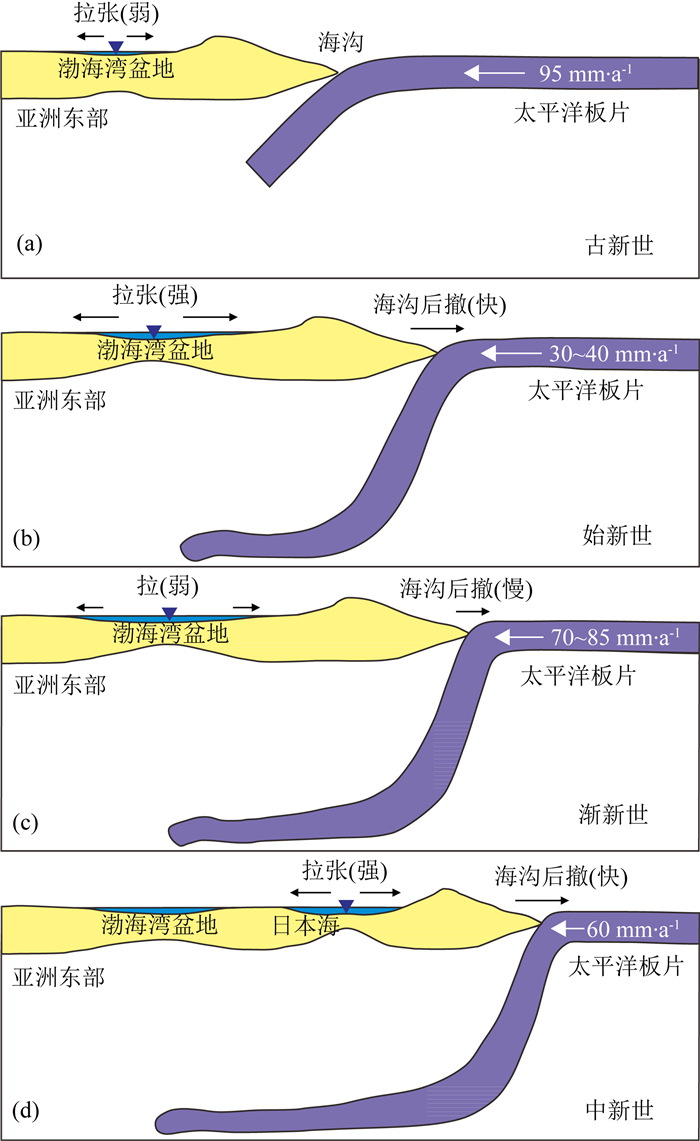
|
图 9 渤海湾盆地新生代演化动力学机制示意图 倒三角表示拉张中心;太平洋板片俯冲速率引自Engebretson等(1985)和Northrup等(1995). Fig. 9 Schematic diagram showing the geodynamic mechanism for the Cenozoic evolution of the Bohai Bay Basin The inverted triangles represent the stretching centers. The subduction rates of the Pacifc Plate are from Engebretson et al. (1985) and Northrup et al. (1995). |
(1) 在多重观测资料的约束下,得到渤海湾盆地新生代拉张开始前的地壳厚度为33~39 km,岩石圈厚度为80~105 km.
(2) 新生代期间,渤海湾盆地各坳陷的总拉张系数为1.28~2.39,沙河街组三段沉积时期拉张系数最大,而沙河街组一段和二段沉积时期的拉张系数相对较小.其中渤中坳陷和辽东湾坳陷的总拉张系数最大,其次是冀中坳陷及济阳坳陷,辽河坳陷和临清坳陷的拉张系数最小.
(3) 盆地的基底热流自新生代初的59~66 mW·m-2开始升高,在古近纪中、晚期达到峰值71~100 mW·m-2,之后逐渐降低至现今.盆地西部冀中、临清等坳陷热流峰期出现的早(36~35 Ma),而盆地东部渤海海域及辽河坳陷热流达峰期的时间较晚(24.6 Ma).
(4) 由盆地拉张系数和基底热流的研究结果得出,盆地的拉张中心从孔店组时期的冀中坳陷及济阳坳陷,经沙河街组四段、三段沉积后迁移到辽东湾、渤中、黄骅及东濮坳陷;沙河街组一段沉积时期,拉张中心转向黄骅及渤中坳陷;东营组沉积时期,拉张中心继续向东、向北迁移到渤中及辽东湾坳陷.渤海湾盆地新生代的拉张有着自西向东,自南向北的迁移.
(5) 太平洋板块新生代期间俯冲速率的变化,可能导致俯冲后撤速率的变化,进而影响弧后的应力状态.太平洋板片的幕式向东后撤可能是造成渤海湾盆地幕式拉张及拉张中心东向迁移的主要机制.
Allen M B, Macdonald D I M, Zhao X, et al. 1997. Early Cenozoic two-phase extension and late Cenozoic thermal subsidence and inversion of the Bohai Basin, northern China. Marine and Petroleum Geology, 14(7-8): 951-972. DOI:10.1016/S0264-8172(97)00027-5 |
Chang J, Qiu N S, Zhao X Z, et al. 2018. Mesozoic and Cenozoic tectono-thermal reconstruction of the western Bohai Bay Basin (East China) with implications for hydrocarbon generation and migration. Journal of Asian Earth Sciences, 160: 380-395. DOI:10.1016/j.jseaes.2017.09.008 |
Chen Z Y, Qiu J T, Wang P J, et al. 2011. Relationship between volcanic rocks and hydrocarbon accumulation during dominant period of basin formation in Liaohe Depression. Acta Sedimentologica Sinica (in Chinese), 29(4): 798-808. |
Cheng X S. 2011. Structural styles in Dongpu Paleogene extensional faulted depression [Ph. D. thesis] (in Chinese). Beijing: China University of Geosciences (Beijing).
|
Davies J H. 2013. Global map of solid Earth surface heat flow. Geochemistry, Geophysics, Geosystems, 14(10): 4608-4622. DOI:10.1002/ggge.20271 |
Dong M, Qi J F, Yang Q. 2012. Tectonic subsidence characteristics of Huanghua depression in Bohai Bay Basin in Cenozoic. Chinese Journal of Geology (in Chinese), 47(3): 762-775. |
Dong M, Qi J F, Yang Q, et al. 2013. Characteristics of extension amounts and their temporal and spatial distribution of the Cenozoic of Huanghua Depression in Bohai Bay Basin. Journal of Palaeogeography (in Chinese), 15(3): 327-338. |
Duan Y H, Wang F Y, Zhang X K, et al. 2016. Three-dimensional crustal velocity structure model of the middle-eastern north China Craton (HBCrust1.0). Science China-Earth Sciences, 59(7): 1477-1488. DOI:10.1007/s11430-016-5301-0 |
Engebretson D C, Cox A, Gordon R G. 1985. Relative motions between oceanic and continental plates in the pacific basin. Geological Society of America Special Papers. Boulder: Geological Society of America, 2061-60.
|
Fan Q C, Sui J L, Zhao Y W, et al. 2008. Preliminary study on garnet peridotite xenolith of Quaternary volcanic rocks in middle Daxing′an Mountain Range. Acta Petrologica Sinica (in Chinese), 24(11): 2563-2568. |
Fang T H, Ma H W. 1999. The composition and thermal structure of the upper mantle lithosphere beneath Kuan-dian area, Liaoning Province—Implications from mantle xenoliths. Geological Review (in Chinese), 45(7): 450-457. |
Gao X L. 2006. Recent activities of the Tan-Lu Fault Zone in the central Bohai Sea and newly generated faults during Neogene in Bohai. Chinese Journal of Geology (in Chinese), 41(2): 355-364. |
Gong H B. 2009. The study of decollement structures in southern Jiyang Depression since Late Mesozoic [Master′s thesis] (in Chinese). Qingdao: China University of Petroleum (East China).
|
Guo X W, Shi X B, Qiu X L, et al. 2007. Cenozoic post-rift unconformity and the accelerated subsidence events of the Jiyang Depression, Bohai Bay Basin and preliminary analyses on their original mechanism. Chinese Journal of Geophysics, 50(2): 412-422. DOI:10.1002/cjg2.v50.2 |
He L J. 1999. Mutiple tectono-thermal modeling of Liaohe Basin in the cenozoic. Chinese Journal of Geophysics (in Chinese), 42(1): 62-68. |
He L J, Wang J Y. 2003. Cenozoic thermal history of the Bohai Bay Basin: Constraints from heat flow and coupled basin-mountain modeling. Physics and Chemistry of the Earth, Parts A/B/C, 28(9-11): 421-429. DOI:10.1016/S1474-7065(03)00062-7 |
He L J, Wang J Y. 2004. Tectono-thermal modelling of sedimentary basins with episodic extension and inversion, a case history of the Jiyang Basin, North China. Basin Research, 16(4): 587-599. DOI:10.1111/bre.2004.16.issue-4 |
He L J. 2014. Numerical modeling of convective erosion and peridotite-melt interaction in big mantle wedge: Implications for the destruction of the North China Craton. Journal of Geophysical Research: Solid Earth, 119(4): 3662-3677. DOI:10.1002/2013JB010657 |
Hou G T, Hari K R. 2014. Mesozoic-Cenozoic extension of the Bohai Sea: Contribution to the destruction of North China Craton. Frontiers of Earth Science, 8(2): 202-215. DOI:10.1007/s11707-014-0413-3 |
Hou W. 2010. Sequence-tectonics-paleo-geomorphology features of Paleogen and their constraints relationship in the east of Liaohe beach area [Ph. D. thesis] (in Chinese). Beijing: China University of Geosciences (Beijing).
|
Hu S B, O′Sullivan P B, Raza A, et al. 2001. Thermal history and tectonic subsidence of the Bohai Basin, northern China: A Cenozoic rifted and local pull-apart basin. Physics of the Earth and Planetary Interiors, 126(3-4): 221-235. DOI:10.1016/S0031-9201(01)00257-6 |
Huang X L, Xu Y G. 2010. Thermal state and structure of the lithosphere beneath eastern China: A synthesis on basalt-borne xenoliths. Journal of Earth Science, 21(5): 711-730. DOI:10.1007/s12583-010-0111-3 |
Jiang G Z, Gao P, Rao S, et al. 2016. Compilation of heat flow data in the continental area of China (4th edition). Chinese Journal of Geophysics (in Chinese), 59(8): 2892-2910. DOI:10.6038/cjg20160815 |
Jolivet L, Tamaki K, Fournier M. 1994. Japan Sea, opening history and mechanism: A synthesis. Journal of Geophysical Research: Solid Earth, 99(B11): 22237-22259. DOI:10.1029/93JB03463 |
Laske G, Masters G, Ma Z, et al. 2013. Update on CRUST1.0-A 1-degree global model of earth′s crust. //EGU General Assembly 2013. Vienna, Austria: EGU, 15: 2658.
|
Li Q R. 2014. Cenozoic tectonic evolution of Bohai Bay Basin and its implications on the Pacific Plate subduction[Master′s thesis] (in Chinese). Beijing: China University of Geosciences (Beijing).
|
Liang J T, Wang H L, Bai Y, et al. 2016. Cenozoic tectonic evolution of the Bohai Bay Basin and its coupling relationship with Pacific Plate subduction. Journal of Asian Earth Sciences, 127: 257-266. DOI:10.1016/j.jseaes.2016.06.012 |
Liu J B. 2011. Cenozoic tectonic and its control of deposition and hydrocarbon accumulation in Jiyang Depression[Ph. D. thesis] (in Chinese). Guangzhou: Guangzhou Institute of Geochemistry, Chinese Academy of Sciences.
|
Liu J Q, Wang S S. 1982. The formation time of Changbai Mountain volcano and Tianchi. Chinese Science Bulletin (in Chinese), (21): 312-1315. |
Liu Q Y, He L J. 2015. Discussion on several problems in tectono-thermal modeling of rift basins. Chinese Journal of Geophysics, 58(2): 179-191. DOI:10.1002/cjg2.2015.58.issue-2 |
Liu Q Y, He L J, Huang F, et al. 2016a. Cenozoic lithospheric evolution of the Bohai Bay Basin, eastern North China Craton: Constraint from tectono-thermal modeling. Journal of Asian Earth Sciences, 115: 368-382. DOI:10.1016/j.jseaes.2015.10.013 |
Liu Q Y, Zhang L Y, Zhang C, et al. 2016b. Lithospheric thermal structure of the North China Craton and its geodynamic implications. Journal of Geodynamics, 102: 139-150. DOI:10.1016/j.jog.2016.09.005 |
Liu Q Y, He L J, Chen L C. 2018. Tectono-thermal modeling of Cenozoic multiple rift episodes in the Bohai Bay Basin, eastern China and its geodynamic implications. International Journal of Earth Sciences, 107(1): 53-69. DOI:10.1007/s00531-017-1550-1 |
Luo L, Qi J F, Li H X, et al. 2017. Geometry and evolution of the Cangdong sag in the bohai bay basin, china: Implications for subduction of the Pacific Plate. Scientific Reports, 7(1): 15393. DOI:10.1038/s41598-017-15759-x |
Mao L G. 2014. Characteristics of rifting interfered by magmatic diapirsm, an example from Paleogene Jizhong Rift of Bohai Bay Basin, East China[Ph. D. thesis] (in Chinese). Hangzhou: Zhejiang University.
|
McKenzie D. 1978. Some remarks on the development of sedimentary basins. Earth and Planetary Science Letters, 40(1): 25-32. DOI:10.1016/0012-821X(78)90071-7 |
Northrup C J, Royden L H, Burchfiel B C. 1995. Motion of the Pacific plate relative to Eurasia and its potential relation to Cenozoic extension along the eastern margin of Eurasia. Geology, 23(8): 719-722. DOI:10.1130/0091-7613(1995)023<0719:MOTPPR>2.3.CO;2 |
Petitjean S, Rabinowicz M, Grégoire M, et al. 2006. Differences between Archean and Proterozoic lithospheres: Assessment of the possible major role of thermal conductivity. Geochemistry, Geophysics, Geosystems, 7(3): Q03021. DOI:10.1029/2005GC001053 |
Pollack H N, Hurter S J, Johnson J R. 1993. Heat flow from the Earth's interior: Analysis of the global data set. Reviews of Geophysics, 31(3): 267-280. DOI:10.1029/93RG01249 |
Qi J F, Yang Q. 2010. Cenozoic structural deformation and dynamic processes of the Bohai Bay basin province, China. Marine and Petroleum Geology, 27(4): 757-771. DOI:10.1016/j.marpetgeo.2009.08.012 |
Qiu N S, Zuo Y H, Chang J, et al. 2014. Geothermal evidence of Meso-Cenozoic lithosphere thinning in the Jiyang sub-basin, Bohai Bay Basin, eastern North China Craton. Gondwana Research, 26(3-4): 1079-1092. DOI:10.1016/j.gr.2013.08.011 |
Qiu N S, Xu W, Zuo Y H, et al. 2015. Meso-Cenozoic thermal regime in the Bohai Bay Basin, eastern North China Craton. International Geology Review, 57(3): 271-289. DOI:10.1080/00206814.2014.1002818 |
Qiu N S, Zuo Y H, Xu W, et al. 2016. Meso-Cenozoic lithosphere thinning in the eastern North China Craton: Evidence from thermal history of the Bohai Bay Basin, North China. The Journal of Geology, 124(2): 195-219. DOI:10.1086/684830 |
Ren F L, Liu Z Q, Qiu L G, et al. 2008. Space-time discrepancy of depressional evolution in the Bohai Bay Basin during Cenozoic. Chinese Journal of Geology (in Chinese), 43(3): 546-557, 575. |
Ren J Y, Tamaki K, Li S T, et al. 2002. Late mesozoic and cenozoic rifting and its dynamic setting in Eastern China and adjacent areas. Tectonophysics, 344(3-4): 175-205. DOI:10.1016/S0040-1951(01)00271-2 |
Schellart W P. 2005. Influence of the subducting plate velocity on the geometry of the slab and migration of the subduction hinge. Earth and Planetary Science Letters, 231(3-4): 197-219. DOI:10.1016/j.epsl.2004.12.019 |
Sclater J G, Christie P A F. 1980. Continental stretching: An explanation of the Post-Mid-Cretaceous subsidence of the central North Sea basin. Journal of Geophysical Research: Solid Earth, 85(B7): 3711-3739. DOI:10.1029/JB085iB07p03711 |
Tang L J, Wan G M, Zhou X H, et al. 2008. Cenozoic geotectonic evolution of the Bohai Basin. Geological Journal of China Universities (in Chinese), 14(2): 191-198. |
Wang D Y, Xu W L, Feng H, et al. 2002. Nature of late Mesozoic lithospheric mantle in western Liaoning province: Evidences from basalt and the mantle-derived xenoliths. Journal of Jilin University (Earth Science Edition) (in Chinese), 32(4): 319-324. |
Wang L S, Liu S W, Xiao W Y, et al. 2002. Distribution feature of terrestrial heat flow densities in the Bohai Basin, East China. Chinese Science Bulletin, 47(10): 857-862. DOI:10.1360/02tb9193 |
Wang Y X, Feng D S, Wang J Y, et al. 2003. Present-day geothermal field and thermal history of Eastern Subdepression, Liaohe Basin. Chinese Journal of Geophysics, 46(2): 275-282. DOI:10.1002/cjg2.v46.2 |
Wang Z Y, Qi J F, Lu K Z. 2000. Analysis of Cenozoic tectonic subsidence history of the east tectonic belts in Huanghua Depression. Oil & Gas Geology (in Chinese), 21(2): 127-129, 167. |
Wangen M. 1995. The blanketing effect in sedimentary basins. Basin Research, 7(4): 283-298. DOI:10.1111/bre.1995.7.issue-4 |
Xie X N, Cui T, Dietmar M R, et al. 2007. Subsidence history and forming mechanism of anomalous tectonic subsidence in the Bozhong depression, Bohaiwan basin. Science in China Series D: Earth Sciences, 50(9): 1310-1318. DOI:10.1007/s11430-007-0095-8 |
Xu X S, O'Reilly S Y, Griffin W L, et al. 1998. The nature of the cenozoic lithosphere at nüshan, eastern China. //Flower M F J, Chung S L, Lo C H, et al eds. Mantle Dynamics and Plate Interactions in East Asia. Washington, DC: American Geophysical Union Geodynamics Series, 167-195.
|
Yang M H, Liu C Y, Yang B Y, et al. 2002. Extensional structures of the Paleogene in the Central Hebei Basin, China. Geological Review (in Chinese), 48(1): 58-67. |
Zhang J T, Wu Z P, Lv M Z, et al. 2014. Tectonic activity difference and its control on hydrocarbon accumulation of volcanic rock reservoir in Eastern and Western Sags of Liaohe Depression. Geoscience (in Chinese), 28(5): 1032-1040. |
Zhao F Y, Jiang S H, Li S Z, et al. 2016. Cenozoic tectonic migration in the Bohai Bay Basin, East China. Geological Journal, 51(S1): 188-202. |
Zheng J P, Griffin W L, O'Reilly S Y, et al. 2006. Mineral chemistry of peridotites from Paleozoic, Mesozoic and Cenozoic lithosphere: Constraints on mantle evolution beneath eastern China. Journal of Petrology, 47(11): 2233-2256. DOI:10.1093/petrology/egl042 |
Zheng T Y, Zhao L, Chen L. 2005. A detailed receiver function image of the sedimentary structure in the Bohai Bay Basin. Physics of the Earth and Planetary Interiors, 152(3): 129-143. DOI:10.1016/j.pepi.2005.06.011 |
Zheng T Y, Chen L, Zhao L, et al. 2007. Crustal structure across the Yanshan belt at the northern margin of the North China Craton. Physics of the Earth and Planetary Interiors, 161(1-2): 36-49. DOI:10.1016/j.pepi.2007.01.004 |
Zhu G Z, Shi Y L, Tackley P. 2010. Subduction of the western Pacific plate underneath Northeast China: Implications of numerical studies. Physics of the Earth and Planetary Interiors, 178(1-2): 92-99. DOI:10.1016/j.pepi.2009.10.008 |
Zhu R X, Xu Y G, Zhu G, et al. 2012. Destruction of the North China craton. Science China Earth Sciences, 55(10): 1565-1587. DOI:10.1007/s11430-012-4516-y |
Zhu W L, Mi L J, Gong Z S. 2009. Hydrocarbon Accumulation and Exploration Offshore the Bohai Sea (in Chinese). Beijing: Science Press.
|
Zuo Y H, Qiu N S, Pang X Q, et al. 2013. Geothermal evidence of the Mesozoic and Cenozoic lithospheric thinning in the Liaohe Depression. Journal of Earth Science, 24(4): 529-540. DOI:10.1007/s12583-013-0347-9 |
Zuo Y H, Qiu N S, Hao Q Q, et al. 2014. Present geothermal fields of the Dongpu Sag in the Bohai Bay basin. Acta Geologica Sinica (English Edition), 88(3): 915-930. DOI:10.1111/acgs.2014.88.issue-3 |
Zuo Y H, Ye B, Wu W T, et al. 2017. Present temperature field and Cenozoic thermal history in the Dongpu depression, Bohai Bay Basin, North China. Marine and Petroleum Geology, 88: 696-711. DOI:10.1016/j.marpetgeo.2017.08.037 |
陈振岩, 仇劲涛, 王璞珺, 等. 2011. 主成盆期火山岩与油气成藏关系探讨. 沉积学报, 29(4): 798-808. |
程秀申. 2011.东濮古近纪伸展断陷构造样式[博士论文].北京: 中国地质大学(北京). http://cdmd.cnki.com.cn/Article/CDMD-11415-1011077492.htm
|
董敏, 漆家福, 杨桥. 2012. 渤海湾盆地黄骅坳陷新生代沉降特征. 地质科学, 47(3): 762-775. DOI:10.3969/j.issn.0563-5020.2012.03.014 |
董敏, 漆家福, 杨桥, 等. 2013. 渤海湾盆地黄骅坳陷新生代伸展量的时空分布特征. 古地理学报, 15(3): 327-338. |
樊祺诚, 隋建立, 赵勇伟, 等. 2008. 大兴安岭中部第四纪火山岩中石榴石橄榄岩捕虏体的初步研究. 岩石学报, 24(11): 2563-2568. |
方同辉, 马鸿文. 1999. 辽宁宽甸地区上地幔岩石圈组成及热结构——来自地幔岩包体的信息. 地质论评, 45(7): 450-457. |
高祥林. 2006. 渤海中部郯庐断裂带的近期活动与渤海新近纪新生断裂. 地质科学, 41(2): 355-364. DOI:10.3321/j.issn:0563-5020.2006.02.015 |
宫红波. 2009.济阳坳陷南部晚中生代以来滑脱构造研究[硕士论文].青岛: 中国石油大学(华东). http://cdmd.cnki.com.cn/Article/CDMD-10425-2009221716.htm
|
何丽娟. 1999. 辽河盆地新生代多期构造热演化模拟. 地球物理学报, 42(1): 62-68. DOI:10.3321/j.issn:0001-5733.1999.01.007 |
侯伟. 2010.辽河滩海东部古近系层序-构造-古地貌特征及其制约关系[博士论文].北京: 中国地质大学(北京). http://www.wanfangdata.com.cn/details/detail.do?_type=conference&id=7930976
|
姜光政, 高堋, 饶松, 等. 2016. 中国大陆地区大地热流数据汇编(第四版). 地球物理学报, 59(8): 2892-2910. DOI:10.6038/cjg20160815 |
李倩茹. 2014.渤海湾盆地新生代构造演化特征及其对太平洋板块俯冲作用的指示意义[硕士论文].北京: 中国地质大学(北京). http://cdmd.cnki.com.cn/Article/CDMD-11415-1014233919.htm
|
刘嘉麒, 王松山. 1982. 长白山火山与天池的形成时代. 科学通报, (2): 1312-1315. |
刘见宝. 2011.济阳坳陷新生代构造及其对沉积、油气成藏的控制[博士论文].广州: 中国科学院广州地球化学研究所. http://www.wanfangdata.com.cn/details/detail.do?_type=degree&id=Y2031568
|
毛黎光. 2014.岩浆底辟干扰下的裂陷盆地发育特征——以古近纪渤海湾盆地冀中坳陷为例[博士论文].杭州: 浙江大学. http://www.wanfangdata.com.cn/details/detail.do?_type=degree&id=Y2662320
|
任凤楼, 柳忠泉, 邱连贵, 等. 2008. 渤海湾盆地新生代各坳陷沉降的时空差异性. 地质科学, 43(3): 546-557, 575. DOI:10.3321/j.issn:0563-5020.2008.03.009 |
汤良杰, 万桂梅, 周心怀, 等. 2008. 渤海盆地新生代构造演化特征. 高校地质学报, 14(2): 191-198. DOI:10.3969/j.issn.1006-7493.2008.02.008 |
王冬艳, 许文良, 冯宏, 等. 2002. 辽西中生代晚期岩石圈地幔的性质:来自玄武岩和地幔捕虏体的证据. 吉林大学学报:地球科学版, 32(4): 319-324. |
王子煜, 漆家福, 陆克政. 2000. 黄骅坳陷东部构造带新生代构造沉降史分析. 石油与天然气地质, 21(2): 127-129, 167. DOI:10.3321/j.issn:0253-9985.2000.02.008 |
杨明慧, 刘池阳, 杨斌谊, 等. 2002. 冀中坳陷古近纪的伸展构造. 地质论评, 48(1): 58-67. DOI:10.3321/j.issn:0371-5736.2002.01.010 |
张江涛, 吴智平, 吕明针, 等. 2014. 辽河坳陷东、西部凹陷构造活动差异性对火山岩油气成藏的控制作用. 现代地质, 28(5): 1032-1040. DOI:10.3969/j.issn.1000-8527.2014.05.019 |
朱伟林, 米立军, 龚再升. 2009. 渤海海域油气成藏与勘探. 北京: 科学出版社.
|
 2019, Vol. 62
2019, Vol. 62


